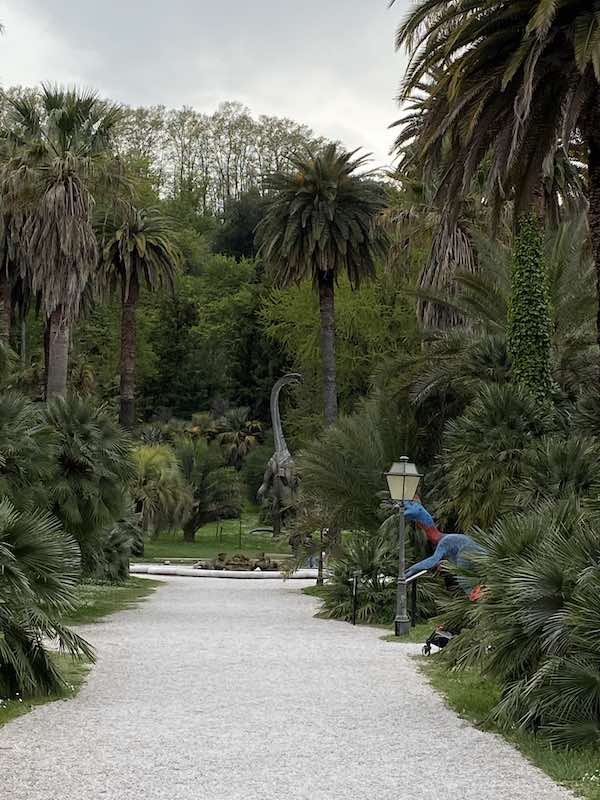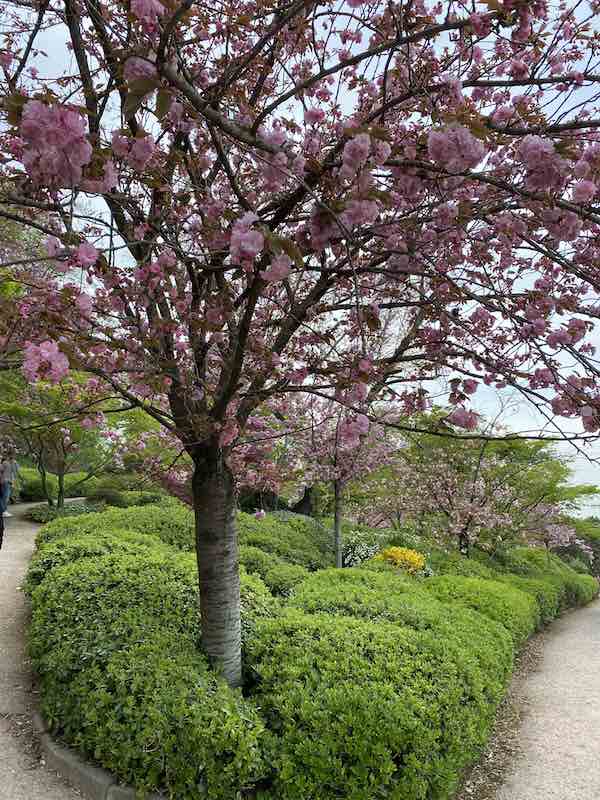All you need to know to visit Rome Botanical Gardens (Orto Botanico di Roma): why go, how to get tickets, visiting the gardens with kids, what to do nearby
The Botanical Gardens of Rome are a lovely oasis of peace and greenery in the heart of Rome city.
Located in Trastevere, they develop at the foothills and on the slope of the Janiculum Hill and they are a treat for plant lovers and not only.
Quiet, safe and well kept, the Botanical Garden of Rome is a beautiful park where you find peculiar plants, lovely pathways for a relaxing walk and several beautiful viewpoints to enjoy unexpected views over the city.
Rome Botanical gardens are off the most beaten tourist track and a true Rome hidden gem: are perfect to escape the crowds and tap into a completely different yet truly Roman experience.

We visit the gardens regularly: we have been in the winter, in the delightful spring seasons, we have seen them with kids and without.
We highly recommend you also go visit. his is our guide to visiting Rome’s Botanical Gardens, what to expect, tips and information on what you can and where you can eat nearby.
Please note: the photos in this post show dinosaurs in the garden as they were take during a temporary exhibition. Sadly, the dinosaurs are now usually there, which is a shame as they were great fun for kids!
Rome Botanical Gardens: location and how to get there
The Botanical Gardens of Rome are in Trastevere. Their full address is: Orto Botanico di Roma, Largo Cristina di Svezia, 23 A – 24, 00165 , Rome.
They closest bus stops are on nearby Viale Trastevere and are served by tram n8 and buses 23 o 280.
From the bus stop, you need to take a short walk along pretty cobbled streets: the gardens are at the end of Via Corsini where you find a large gate and ticket booth.
Please note: I highly recommend you wear comfortable;e walking shoes for the Botanical gardens. The area outside of them ha Rome’s traditional cables and there is a good bit of walking to be done inside the gardens.
you can find here >>> my recommended shoes for Rome sightseeing.
Opening Hours, Tickets and admission
Admissions to Rome’s botanical gardens is ticketed and tickets can be purchased on the day.
There is usually no need for advance booking, unless there are special events such as guided tours, for which a reservation is mandatory.
Tickets prices in 2022 are:
- Kids under 6: free
- Full fee: 4 Euro
- Butterfly house (inside the gardens, extra charge): 4 Euro
Official web address and contact for special event booking >>> click here <<<
Opening Hours:
Open everyday, including Sunday and holidays: 9:00 am – 6:30 pm.
What to see in Rome’s botanical gardens
Rome’s botanical gardens have several beautiful areas with different types of vegetation and layouts.
Among the most impressive, there are:
The Palms Gardens
The main path crossing the length of Rome’s Botanical Gardens is called ‘Palm Avenue’ and it is easy to see why!
As the name suggests, this large path is surrounded by palms bit and small that envelop you in a wonderful, green embrace of pointy leaves swaying in the breeze.
The avenue ends at the monumental and beautiful fountain of the Tritons, a garden’s landmark.

The garden of the senses
beside Palm Avenue and the entrance, you find the interesting sensory garden.
This is a compact area with several water containers with plants characterised by unusual characteristics such as especially strong perfume and it is accessible to visibly impaired visitors thanks to info panels in Braille.
The Rose Gardens
The Rose Gardens (not to be confused with the Garden of The Roses in the Aventine Hill, also in Rome) is a delightful area of Rome’s botanical gardens with beautiful rose bushes.
the Rose garden develops on a slope and, in the blossoms season, is a sensory delight: the color of the roses and their smell envelop you and, due to its elevated position. the garden also offers pretty views of the city!

The bamboo forest
Rome’s botanical gardens has a small bamboo forest. While not comparable with what you may experience in places like Kyoto, the forest here is cute and botanically significant as nothing of the sort is otherwise present in Rome.
This bamboo display s right beside the Japanese Gardens and Cherry Trees area, which gives this all garden area a distinctive Japanese feel and botanical consistency
The Japanese Garden
The Japanese Garden is the most popular and, arguably, the most beautiful area of Rome’s botanical gardens
the Garden develops on a slope and, in typical Japanese fashion and symbolism, gets the visitors to walk along a meandering path leading among beautiful cherry trees, ponds and sitting areas.

The gardens is an absolute delight and, in spring, is one of the best places to see cherry blossoms in Rome.
In spring, you can visit this area on your own or opt for a guided tour with a botanist, who will also explain the story of the arrival of the cherry trees in Rome and the fascinating symbolism behind the layout of Japanese Gardens.
The Staircase of 11 Fountains
Maybe the most impressive manmade attraction in Rome’s botanical gardens, the staircase of 11 fountains is just what the name suggest: monumental steps with eleven water spouts spilling water!
The steps are the main passage between the top and and lower part of the garden and are beautiful and pretty to photograph.

The butterfly house
the butterfly house is an enclose pavilion close to the Steps where you you can get up close and personal to free butterflies.
the entrance is ticketed separately from the rest and costs 4 euro. I am going to be honest wit you: I do not like butterflies (this is. huge understatement as I have a n actual phobia for them) and I refused to enter, so I cannot tell you what’s it like inside!
My visit companions, however, went in and mentioned it as a highlight, especially for the kids. So if you are not like me and you are not battling unusual phobias, this can be worth seeing!
Orto dei Semplici
Orto dei Semplici is one of the most fascinating areas of Rome’s botanical gardens as it hosts medicinal plants.
The pants here come in all shape and sizes, some with colorful flowers, and some without.
Even more than in the rest of the garden, it is important not to touch these plants unless invited to do so by your tour guide as these plants can be poisonous if not used properly.

The Greenhouses
Rome’s botanical gardens have beautiful greenhouses with plants from different parts of the world.
The greenhouses are located close to the entrance and include several species including tropical ones that would not survive in the open and are beautiful to see in and out.
The Mediterranean Garden
the mediterranean Garden is a lovely part of Rome’s botanical gardens with plants that are typical of the mediterranean climate, which is typical of Rome.
While potentially less exotic than other areas such as the Japanese one, this is a lovely area and a perfect place to get to know local plants that you will also be able to find around Rome and Italy.
Other plants and gardens
As well as the gardens mentioned above, there are many other plants and green areas in Rome’s botanical gardens which you will notice as you stroll around this beautiful park.
Among the many species who call this garden home, you will find sequoias, ginkos, pine trees, a lovely rock garden and many species of aquatic plants, thriving in the well kept fountains of the garden.
Visiting Rome’s Botanical Gardens with kids
Rome’s Botanical Gardens are lovely to visit with kids.
The gardens are entirely car free and offer long and safe paths for children to run around, see plants and get a bit of fresh air, despite being very much in the centre of Rome!
The Botanical Gardens are stroller friendly and the area close to the entrance is flat. Iside, there are restroom facilities and feee drinking water, which you can drink from the several drinking fountains dotting the park.
The gardens are in the heart of Trastevere so there are many cafes and restaurants nearby should you want to stop for a snack.
In the Botanical Gardens there are no playground or play areas as such, but the terrain is varied enough for small ones to have fun just trotting around. Older kids are likely to enjoy the beautiful Japanese Gardens especially and the butterfly house.
On special days, the Gardens hosts kids’ events called ‘Orto dei Piccoli’. to introduce children to the magical world of plants and ecosystems (in Italian).
You can find info about kids’ events >> here <<
What to do nearby
A visit to Rome’s Botanical Gardens will take up to a couple of hours and will see you coming to the very heart of Trastevere.
Others thing you can do nearby are:
- Take a mosaic class in the stunning mosaic workshop on Via Corsini, run by a real mosaic artists
- Have a mean in one of Trastevere’s many amazing restaurants (tonnarello in piazza della scala may seem tourist for the outside but it is delicious for pasta)
- Take a self-guided walking tour of Trastevere following our Trastevere itinerary to discover this stunning and unique area of Rome
I hope you enjoyed this quick guide about Rome’s botanical gardens and it inspired you to visit. Safe travel planning!
